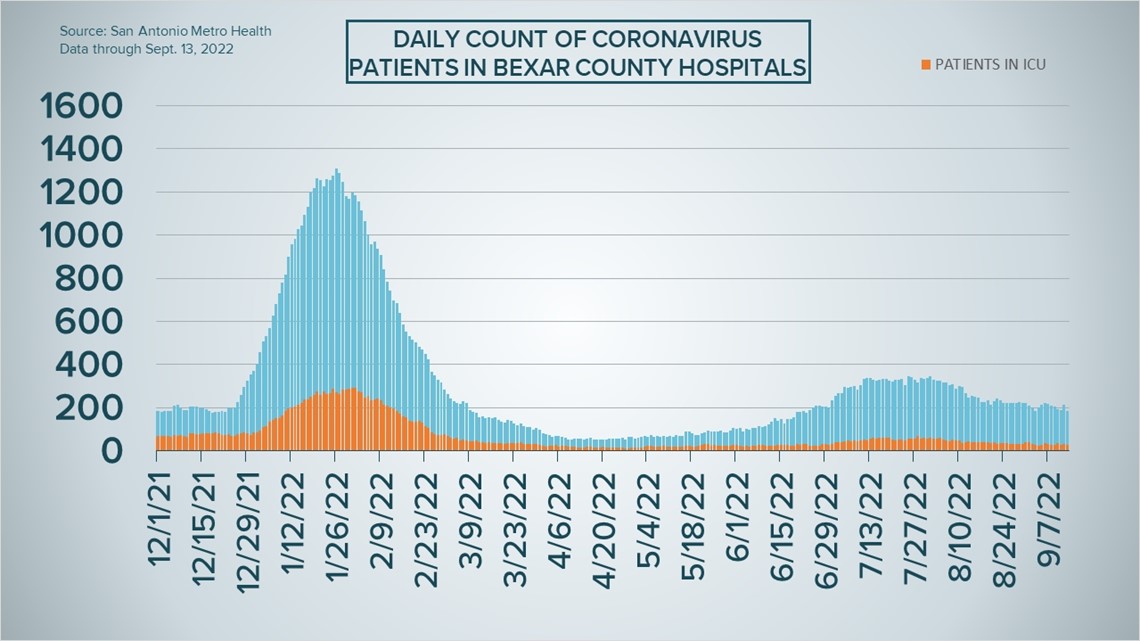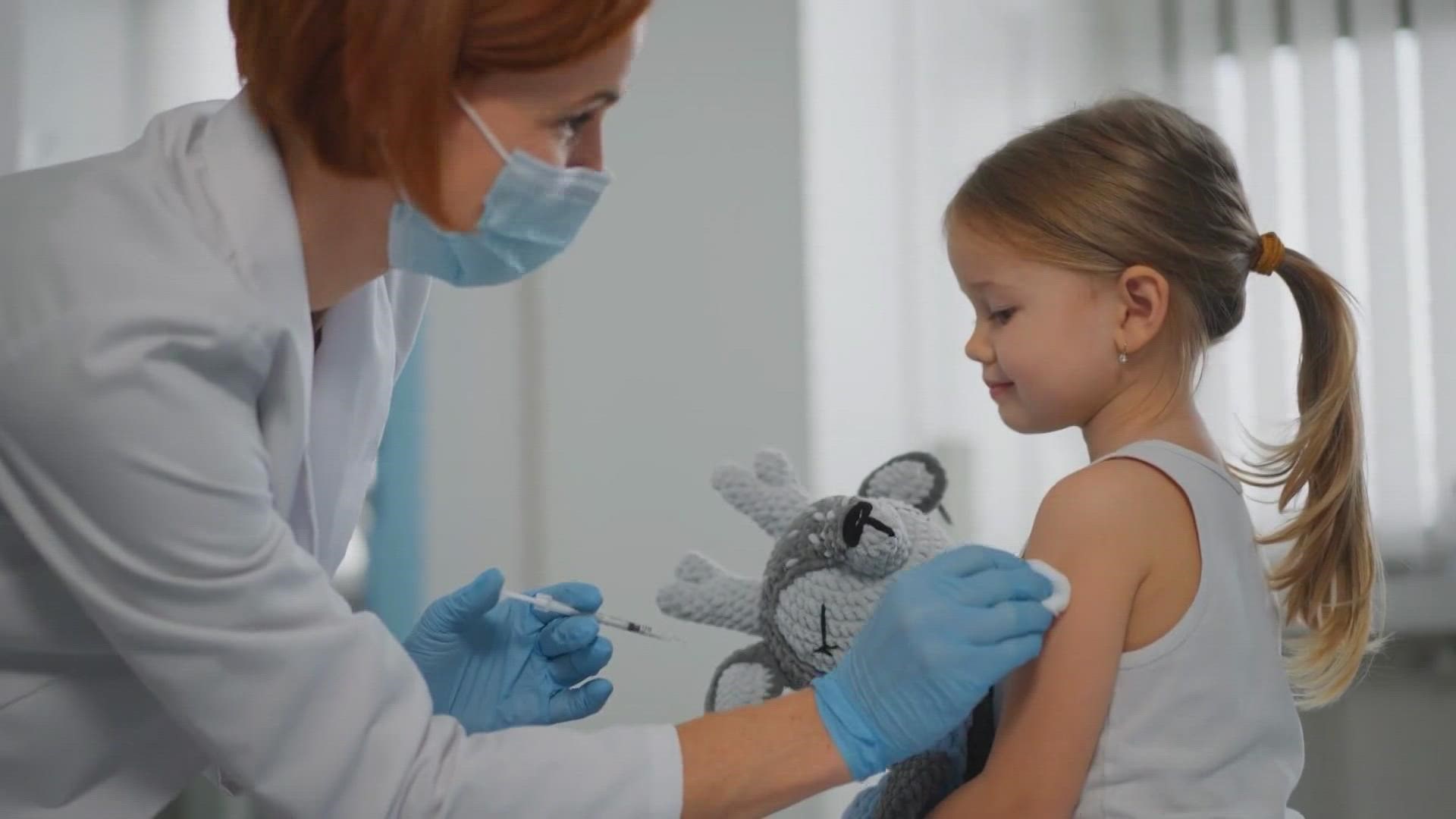SAN ANTONIO — Bexar County health authorities have downgraded the community's coronavirus risk level to "medium" – and "improving" – for the first time since late June as San Antonio has managed to avoid a new wave of infections stemming from the start of the new school year.
September has averaged 586 new cases a day thus far, down from 735 in August and nearly 1,000 in July. That includes 383 infections reported by Metro Health on Tuesday, one of the lowest case counts of recent weeks.
Hospitalizations have also started to trend down after being stagnant for a few weeks. On Tuesday there were 185 COVID-19 patients receiving treatment in local hospitals, down 16% from this time last week and 25% since August 13. Of those 185 patients, 27 were in intensive care and eight on ventilators.
The continuing downward trends come as Metro Health prepares to host pop-up vaccine clinics once again this weekend, starting on Thursday. The latest COVID-19 booster shots are being made available this week to those who are fully immunized up to this point, and H-E-B gift cards are being offered while supplies last to those who come for a shot.
No new deaths were reported Tuesday, although Metro Health did record two virus-related fatalities in the community on Monday. At least 5,361 San Antonio-area residents have died from coronavirus complications while more than 636,000 infections have been reported.
How Bexar County is trending




Vaccine progress in Bexar County
The following numbers are provided by San Antonio Metro Health. A full breakdown can be found here.
- 1,469,228 eligible Bexar County residents are fully vaccinated as of August Sept. 13, which is about 77.5% of the total population over the age of 4.
- 571,536 eligible Bexar County residents have received a COVID-19 booster shot as of Sept. 13, which is 40.4% percent of the population.
The CDC states that "when a high percentage of the community is immune to a disease (through vaccination and/or prior illness)," that community will have reached herd immunity, "making the spread of this disease from person to person unlikely."
The City of San Antonio breaks down the vaccination rates by zip code on Metro Health's Vaccination Statistics page.
Coronavirus in Texas
The total number of coronavirus cases in the state grew by 4,351 on Monday, according to the Texas Department of State Health Services. That total includes 2,923 new confirmed cases and 1,428 new probable cases. More details can be found on this page.
Monday's figures bring the total number of Texans diagnosed with COVID-19 to more than 7.8 million. Tuesday's figures haven't been released as of yet.
A lone additional Texas has died from virus complications, the state reported Monday, raising the statewide death toll to 88,842.
Coronavirus symptoms
The symptoms of coronavirus can be similar to the flu or a bad cold. Symptoms include fever or chills, cough, shortness of breath or difficulty breathing, fatigue, muscle or body aches, headache, new loss of taste or smell sore throat, congestion or runny nose, nausea or vomiting, and diarrhea, according to the Centers for Disease Control.
Most healthy people will have mild symptoms. A study of more than 72,000 patients by the Centers for Disease Control in China showed 80 percent of the cases there were mild.
But infections can cause pneumonia, severe acute respiratory syndrome, kidney failure, and even death, according to the World Health Organization. Older people with underlying health conditions are most at risk.
Experts determined there was consistent evidence these conditions increase a person's risk, regardless of age:
- Chronic kidney disease
- COPD (chronic obstructive pulmonary disease)
- Obesity (BMI of 30 or higher)
- Immunocompromised state (weakened immune system) from solid organ transplant
- Serious heart conditions, such as heart failure, coronary artery disease, or cardiomyopathies
- Sickle cell disease
- Type 2 diabetes
- The CDC believes symptoms may appear anywhere from two to 14 days after being exposed.
Human coronaviruses are usually spread...
- Between people who are in close contact with one another (within about 6 feet).
- Through respiratory droplets produced when an infected person coughs, sneezes or talks. These droplets can land in the mouths or noses of people who are nearby or possibly be inhaled into the lungs.
- Some recent studies have suggested that COVID-19 may be spread by people who are not showing symptoms.
Help stop the spread of coronavirus
- Stay home when you are sick.
- Eat and sleep separately from your family members
- Use different utensils and dishes
- Cover your cough or sneeze with your arm, not your hand.
- If you use a tissue, throw it in the trash.
Find a testing location
City officials recommend getting a COVID-19 test if you experience fever or chills, cough, shortness of breath or difficulty breathing, fatigue, muscle or body aches, headache, new loss of taste or smell, sore throat, congestion or runny nose, nausea or vomiting, or diarrhea.
Here's a Testing Sites Locator to help you find the testing location closest to you in San Antonio.
Latest Coronavirus Headlines
- $100 H-E-B gift cards offered for getting new COVID booster
- New COVID-19 boosters have arrived in Central Texas
- VERIFY: Fact-checking claims about the new COVID boosters
- As new COVID-19 boosters roll out, people consider getting their flu vaccine at the same time
- $20 million secured to help San Antonio small businesses recover from pandemic
- Holiday air travel tops pre-pandemic levels for the first time
- US life expectancy last year fell to the lowest age since 1996

